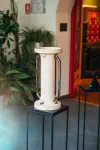
All I Can See Are Ghosts
Co-Producers and Support : Réseau Art Nouveau, Casa Darvas House, Art as a New Eutopia, Creative Europe, Oradea Heritage, Prin Banat
Collaboration with : Laszlo Ceramics, Ferenc Halmos
Photos credit : Motion Sight, Guillaume Slizewicz.
A design research on heritage, ceramics and craftmanship in the city of Oradea
A two-room exhibition revisiting the architectural and artistic heritage of the Darvas House in Oradea
The winter garden owns an installation called “All I can see are ghosts”, paying tribute to the displaced civilians of Oradea’s recent history and more specifically to the fate of Oradea’s Jewish community during the Holocaust.
In the span of a few years, Oradea’s Jewish community, a good fourth of its total population, was decimated. Only a few hundred returned from the death camps. This story is tightly linked to the Darvas House as it is a signature edifice of the Hungarian Jewish fin-de-siècle Bourgeoisie, which turnt Oradea into the “Paris on the Petze Creek”, a bitter-sweet allegory coined by the poet Endre Ady. The house was commissioned by a successful Jewish businessman, Imre Darvas, and built with the help of Jewish architects, the Vágó Brothers, László and József Vágó.
This installation is one of remembrance, of meditation, on the places that stay when people are killed or displaced.
While the first room invites reflection on loss and memory, the second explores how material, form, and colour can echo architectural heritage and bring it forward, reaching the present.
In the hallway, we can find “Colors in Shapes”, an exhibition of ceramic objects boasting various shapes and glazes, inspired by the house’s architecture and responding to this year’s topic, determining International Art Nouveau Day: ‘Color’. During the two weeks I spent in Oradea, I had a chance to explore with clay and produce a series of vases and ornamental buttons inspired by both the architectonic and decorative elements of the Darvas villa: the “coffin lid”- shaped ceiling, characteristic of then-contemporary Finnish and Hungarian architecture, reflected in the all-encompassing trapezoid openings and octagonal decorative details, and the façade cladding showing by a plethora of ornamental buttons. These elements were transferred into clay via new technologies, 3D modelling, and 3D printing.
The resulting elements have been glazed with colors reflecting the building’s stained glass pieces and the façade’s ornamental cycle: green eosin, antique gold, metallic, blue, green, and yellow glazes in different mixes and proportions. The objects on show are of different stages of production . A handful are finished, and some artefacts are still in progress. This allows us to see how the glaze color works with different shapes and surfaces, showing a glimpse of what’s possible when merging ancestral techniques with new technologies.
The elements are arranged around a wooden circle that references the Darvas family’s wood production origins while symbolically showing the alchemical transformation of timber to ceramic through their patronage.
The pieces were manufactured with the caring help of Attila László and Ferenc Halmos.


